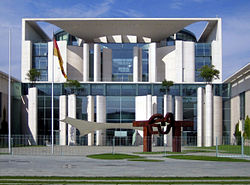German Chancellery: Difference between revisions
Vegaswikian1 (talk | contribs) removed Category:2001 architecture; added Category:Buildings and structures completed in 2001 using HotCat |
No edit summary |
||
| Line 56: | Line 56: | ||
*[[Thomas de Maizière]] (CDU), 2005–2009 |
*[[Thomas de Maizière]] (CDU), 2005–2009 |
||
*[[Ronald Pofalla]] (CDU), since 2009 |
*[[Ronald Pofalla]] (CDU), since 2009 |
||
== See also == |
|||
* [[Reich Chancellery]] |
|||
== References == |
== References == |
||
Revision as of 19:39, 19 November 2011
 | |
| Agency overview | |
|---|---|
| Formed | 1871 |
| Jurisdiction | Government of Germany |
| Agency executive |
|
| Website | http://www.bundeskanzleramt.de |
The German Chancellery (‹See Tfd›German: Bundeskanzleramt) is a federal agency serving the executive office of the Chancellor, the head of the German federal government. The chief of the Chancellery (Chef des Bundeskanzleramtes) holds the rank of either a Secretary of State (Staatssekretär) or a Federal Minister (Bundesminister). The agency's primary function is to assist the Chancellor in coordinating the activities of the Federal Government. The current chief of the Chancellery is Minister Ronald Pofalla.
Bundeskanzleramt is also the name of the building in Berlin that houses the personal offices of the Chancellor and the Chancellery staff.
History




- Berlin 1871-1945. The Chancellery was established in 1871 as the Reichskanzlei (Imperial Chancellery) of the German Empire and originally had its seat in the Radziwiłł Palace (also known as Reichskanzlerpalais), originally built by Prince Antoni Radziwiłł on Wilhelmstraße 77 in Berlin. In 1938–39, the Neue Reichskanzlei (New Imperial Chancellery), designed by Albert Speer, was built; its main entrance was located at Voßstraße 6, while the building occupied the entire northern side of the street. It was damaged during World War II and later demolished by Soviet occupation forces.
- Bonn 1949-1999. After the war, Bonn became seat of the West German government and the Chancellery (now known as the Bundeskanzleramt — Chancellor's Office) moved into Palais Schaumburg until a new Chancellery building was completed in 1976. The new West German Chancellery building was a black structure completed in the International Style, in an unassuming example of modernism. A separate building Kanzlerbungalow in Bonn served as a private apartment/residence of the Chancellor and his family 1964-1999.
- Berlin 1999-2001. In the summer of 1999, as part of the German government's move to Berlin, the Chancellery was temporarily housed in the former GDR State Council building (Staatsratsgebäude) as the new Chancellery building was not yet finished at the time.
Berlin 2001: the new Chancellery building
The current Chancellery building (opened in the spring of 2001) was designed by Charlotte Frank and Axel Schultes and was built by a joint venture of Royal BAM Group's subsidiary Wayss & Freytag and the Spanish Acciona[1] from concrete and glass in an essentially postmodern style, though some elements of modernist style are evident. Occupying 12,000 square meters (129,166 square feet), it is also one of the largest government headquarters buildings in the world. By comparison, the new Chancellery building is eight times the size of the White House.[2] A semi official Chancellor apartment is located on the top floor of the building. The 200 square meters two-room flat was only occupied by Gerhard Schröder. Mrs. Merkel uses her private apartment in Berlin. Because of its distinctive but controversial architecture, journalists, tourist guides and some locals refer to the buildings as Kohllosseum (as a mix of collosseum and former chancellor Helmut Kohl under whom it was built), Bundeswaschmaschine (federal laundry machine; because of the round-shaped windows and its cubic form), or Elefantenklo (elephant loo).
Visitors
Access for the general public is only possible on particular days during the year. Since 1999, the German government has welcomed the general public for one weekend per year to visit its buildings - usually in August.
Heads of the Chancellery
Chiefs (Directors) of the Chancellery attend Cabinet meetings. They may also sit as members of the Cabinet if they are also given the position of Minister for Special Affairs (Minister für besondere Aufgaben). They are often called "Kanzleramtsminister" (chancellery minister).
- Walter Hallstein (CDU), 1950–1951
- Otto Lenz (CDU), 1951–1953
- Hans Globke (CDU), 1953–1963
- Ludger Westrick, 1963–1966
- Werner Knieper, 1966–1967
- Karl Carstens (CDU), 1967–1969
- Horst Ehmke (SPD), 1969–1972
- Horst Grabert (CDU), 1972–1974
- Manfred Schüler (SPD), 1974–1980
- Manfred Lahnstein (SPD), 1980–1982
- Gerhard Konow, 1982
- Waldemar Schreckenberger (CDU), 1982–1984
- Wolfgang Schäuble (CDU), 1984–1989
- Rudolf Seiters (CDU) 1989–1991
- Friedrich Bohl (CDU), 1991–1998
- Bodo Hombach (SPD), 1998–1999
- Frank-Walter Steinmeier (SPD), 1999–2005
- Thomas de Maizière (CDU), 2005–2009
- Ronald Pofalla (CDU), since 2009
See also
References
- ^ Structurae database
- ^ Steven Rosenberg (January 19, 2007). "Merkel's faces tough EU challenge". BBC.
